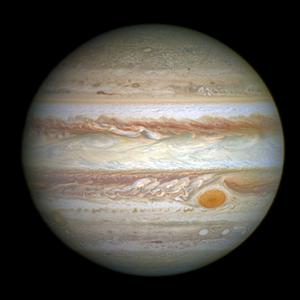Glossarbegriffe: Großer Roter Fleck
Description: Der Große Rote Fleck ist ein riesiger antizyklonaler Sturm in der Atmosphäre des Jupiters 22 Grad südlich seines Äquators. Mit einer Länge von etwa 15.000 Kilometern (km) und einer Breite von fast 12.000 km ist er derzeit etwas größer als die Erde, obwohl er in der Vergangenheit weitaus größere Ausmaße erreicht hat. Die Windgeschwindigkeiten im Inneren des Großen Roten Flecks können mehr als 400 km/h (250 mph) erreichen. Der Grund für seine rote Farbe ist derzeit unbekannt, obwohl es mehrere konkurrierende Hypothesen gibt. Im Jahr 1665 entdeckte der Astronom Giovanni Cassini einen großen roten Fleck auf dem Jupiter, der ein halbes Jahrhundert lang beobachtet wurde. Es gibt jedoch eine jahrhundertelange Lücke in den Beobachtungen, sodass nicht bekannt ist, ob es sich bei diesem Fleck um denselben Großen Roten Fleck handelt, der in den letzten zweihundert Jahren beobachtet wurde.
Zugehörige Glossarbegriffe:
See this term in other languages
Term and definition status: The original definition of this term in English have been approved by a research astronomer and a teacher The translation of this term and its definition is still awaiting approval
The OAE Multilingual Glossary is a project of the IAU Office of Astronomy for Education (OAE) in collaboration with the IAU Office of Astronomy Outreach (OAO). The terms and definitions were chosen, written and reviewed by a collective effort from the OAE, the OAE Centers and Nodes, the OAE National Astronomy Education Coordinators (NAECs) and other volunteers. You can find a full list of credits here. All glossary terms and their definitions are released under a Creative Commons CC BY-4.0 license and should be credited to "IAU OAE".
Zugehörige Medien
Jupiter
Bildnachweis: NASA, ESA, and A. Simon (Goddard Space Flight Center) credit link
License: CC-BY-4.0 Creative Commons Namensnennung 4.0 International (CC BY 4.0) icons









